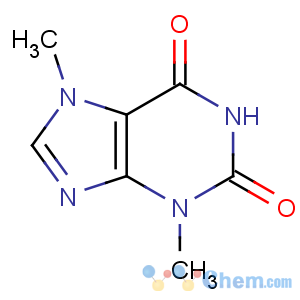copy of CAS 83-67-0 Theobromine
-

Molecular Structure
Detailed Description
CAS 83-67-0 Theobromine
Product Name:Theobromine
Alias:Diurobromine Theobromine,Teobromin,Theominal, Theoxalvose,Riddovydrin
CAS: 83-67-0
MF: C7H8N4O2
MW: 180.16
EINECS: 201-494-2
Assay: 99%
Appearance: White crystal powder
Theobromine, formerly known as xantheose, is a bitter alkaloid of the cacao plant, with the chemical formula C7H8N4O2. It is classified as a xanthine alkaloid, which also includes the similar compounds theophylline. The compounds differ in their degree of methylation.
Health Benefits of Theobromine
Theobromine has a similar effect than caffeine, but about 10 times weaker. Theobromine has diuretic, stimulant and relaxing effects. Theobromine can lower the blood pressure because it can to dilate blood vessels.
Theobromine has stimulant properties, similar to caffeine. Unlike caffeine theobromine does not affect the central nervous system.
Theobromine can also relax bronchi muscles in the lungs. Theobromine can be used as cough medicine. Studies indicate that theobromine acts on the vagus nerve, which runs from the lungs to the brain.
Weight Loss
Theobromine is a mild stimulant and diuretic. Both of these properties can aid weight loss by giving you a little energy boost for physical activity and helping you shed water weight. Theobromine can also help suppress your appetite.Theobromine can be said to promote weight loss in a variety of different ways including vasodilatation, diuresis and the ability to increase energy although most of these seem to be indirect.
Use
In modern medicine, theobromine is used as a vasodilator (a blood vessel widener), a diuretic (urination aid), and heart stimulant. Theobromine increases urine production. Because of this diuretic effect, and its ability to dilate blood vessels, theobromine has been used to treat high blood pressure.

- copy of CAS 83-67-0 Theobromine




